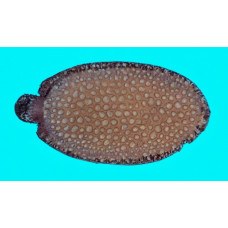Latin name
Pardachirus pavoninus
Other name
Ocellated Sole
Identification
The body shape of the peacock sole is compressed and asymmetrical. The eyes are located on the right side of the body and protrude well above the body. The scales are small, with 77-99 scales on the lateral line. The scales are cycloid on both sides. There are no scales on the dorsal and anal fins. Along the edges of the dorsal and anal fins are numerous pores of venom glands, the total number of which varies from 204 to 237. Most of these glands are concentrated on the right (eye) side of the body. The venom secreted by the glands is dangerous to small fish, and acts as a deterrent to large fish.
Features of fish fins
The dorsal fin of this species is along the entire dorsal part, reaching almost to the mouth. It consists of 62-73 soft rays. The anal fin is slightly shorter than the dorsal fin and consists of 48-55 soft rays. The dorsal and anal fins are separated from the caudal fin. Pectoral fins are absent. The pelvic fins are small and close to the head. They are asymmetrical, with the right fin having an elongated base attached posteriorly to the genital papilla.
Fish colouring
The entire body of the peacock sole is reddish brown. The head is heavily spotted. The body and fins on the right side of the body have spots of various sizes and shapes, surrounded by a dark border, and some have a blackish spot in the centre. The left side of the body is white.
Distribution
Peacock sole are found in the waters of the eastern Indian Ocean and western Pacific Ocean: from Sri Lanka eastwards to Tonga, northwards to southern Japan and southwards to Onslow (western Australia) and New Caledonia.
Habitat
A tropical marine species associated with reefs. Its depth range is from 2 to 40 metres.
Size
The maximum length of fish in this species is up to 25 cm, and the total length of males in this species is 12.5 cm.
Behavior
Peacock sole inhabit the sandy and muddy bottoms of lagoons and coral reefs, where they are predominantly bottom dwellers. They usually burrow into the sand, leaving only their eyes and nostrils above the surface.
Food and feeding habits
The diet of this fish is dominated by bottom invertebrates, mainly small crustaceans, which it hunts by ambush.
Reproduction
Spawning takes place from February to April, as confirmed by the discovery of eggs during this period. It does not occur every year. Eggs are 1.5 mm in diameter. The newborn larvae are 3.35-3.45 mm long. They are initially active, swimming and have a symmetrical body (with eyes on both sides) and pectoral fins. They begin to feed after 3 days and reach a size of 4.2-4.3 mm. At 14-19 days after birth, the larvae begin to lie down on their sides and at 31 days, they become benthic at a size of 11-11.5 mm. At the same time, the left eye gradually moves to the right side and the colouration of both sides begins to diversify. The eye finally moves to the right side at about 37 days and the pectoral fins are almost completely reduced.
Fishing
This species is not commercially important.
Relationship with a person
Peacock sole is not edible and is poisonous to humans.
| Classification | |
| Phylum | Chordata |
| Class | Actinopterygii |
| Squad | Pleuronectiformes |
| Family | Soleidae |
| Genus | Pardachirus |
| Species | P. pavoninus |
| Features | |
| Conservation status | Least Concern |
| Habitat | Bottom |
| Life span, years | No information |
| Maximum body weight, kg | No information |
| Maximum length, cm | 25 |
| Sailing speed, m/s | No information |
| Threat to people | Edible |
| Way of eating | Bentophage |
Peacock sole
Tags: peacock sole

